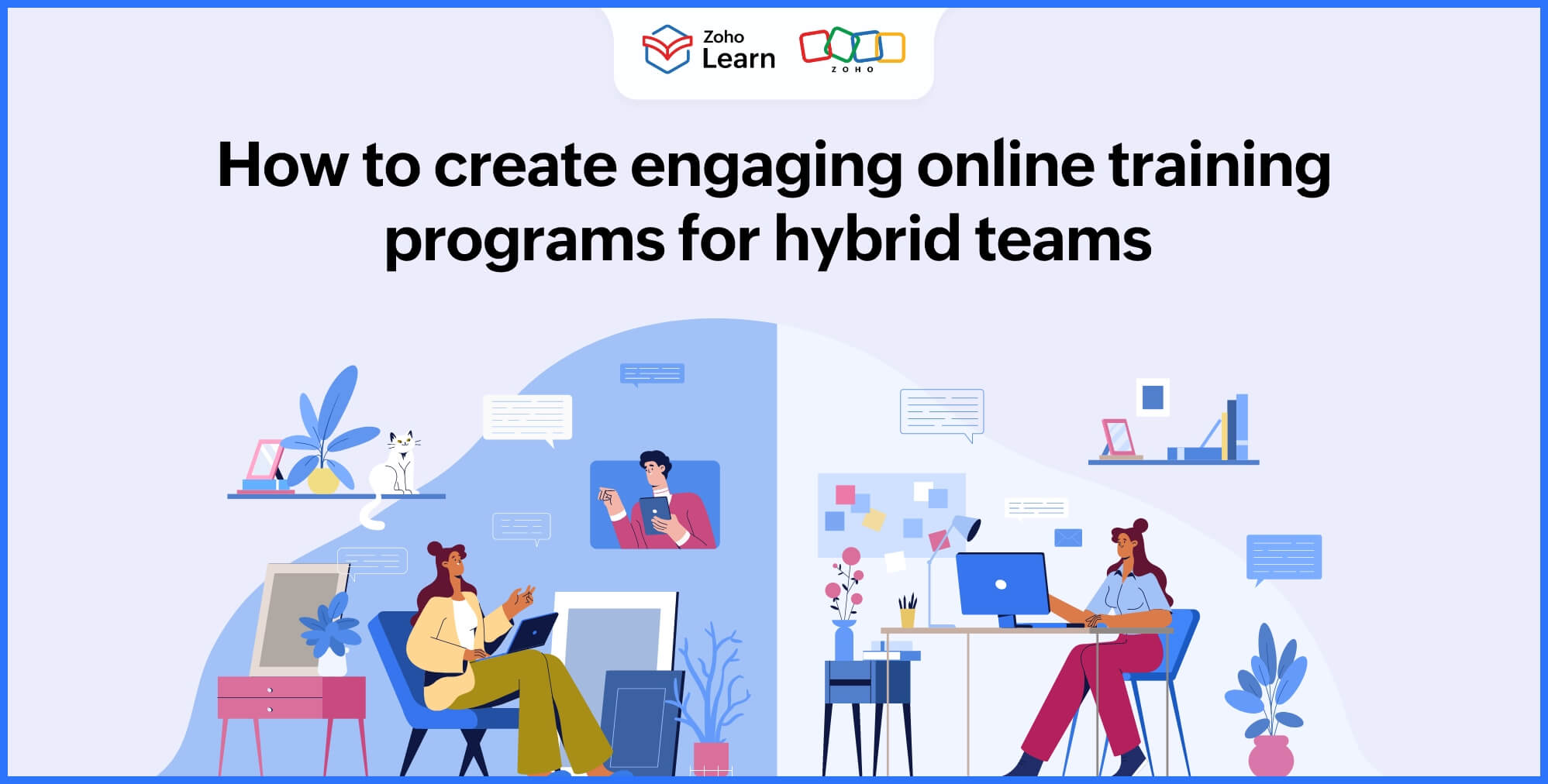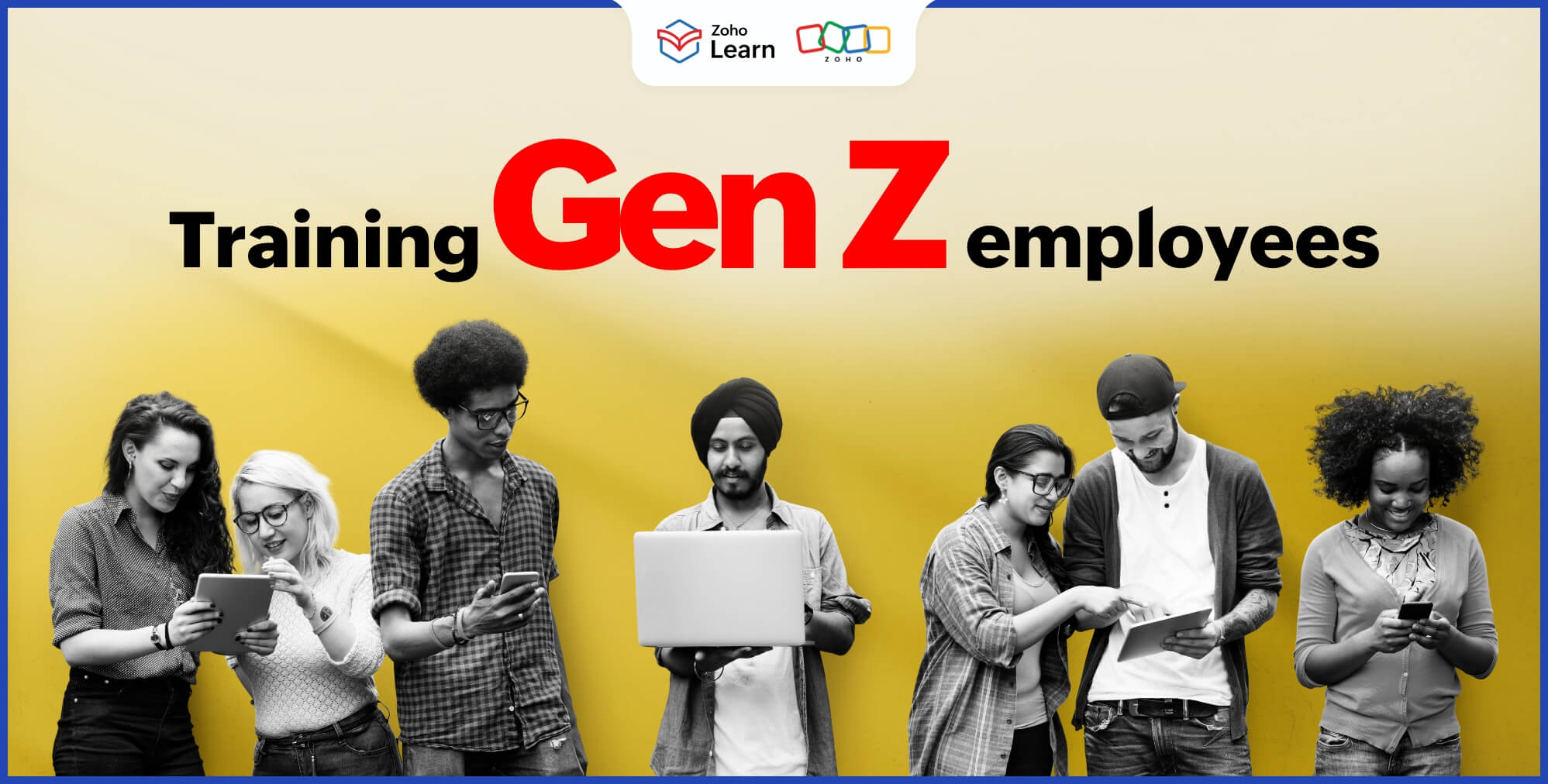How to create engaging online training programs for hybrid teams
- Last Updated : October 29, 2025
- 58 Views
- 5 Min Read

Creating courses and delivering training for employees scattered across home offices, corporate buildings, and even different countries and time zones is a tricky task. Hybrid workspaces offer incredible flexibility and increased productivity but they also offer some unique challenges, which includes creating training programs that work for everyone. If you're wondering how to create training that's engaging and inclusive for all of your hybrid employees, then this is just the post for you.
What are the specific needs of hybrid workplaces?
With a combination of in-person and remote employees, organizations often find themselves in a pitch to deliver training that’s suitable for all kinds of scenarios. Hybrid employees have some specific needs and concerns that need to be looked into before you create training programs.
Accessibility
With employees scattered across different geographical locations, it's necessary to create training programs that are accessible for everyone. Cloud-based learning solutions with both desktop provisions and mobile apps will come handy in this case.
Flexibility
Hybrid employees need training programs that fit into their schedules seamlessly. Creating self-paced courses can help your team take the training at their own pace and time and provide them with a more flexible lifestyle.
Consistent communication
With fewer in-person touchpoints, it's harder for all of your employees to experience the same kind of interaction with their leaders. Ensure that you have in-app and email notifications with various nudges and training updates so that your team is aware of what's going on and what’s needed from their side.
Technological illiteracy
It's more common for hybrid employees to struggle with technology as they're largely removed from their peers. Ensure that you don't over-complicate training with multiple platforms for different needs. Choose a user-friendly LMS that makes training feel like a breeze for your team.
A step-by-step guide to create online training programs for hybrid workplaces
There are several factors that need to be considered while training hybrid employees. It's crucial to look for ways to integrate training within the work routine and choose a platform that fits into your organization seamlessly while addressing the major struggles. Here’s a step-by-step guide for creating online training programs that will cater to the main needs of hybrid employees.
Figure out your training needs and goals
First, ensure that there’s an alignment in training goals and expectations within the organization. Then, conduct a needs analysis and figure out the skill gaps amongst your hybrid employees. Devise training strategies depending on the skills your hybrid employees need and the goals your organization sets.
Choose the right LMS platform
The perfect LMS for a hybrid workplace requires an interactive course builder to engage all kinds of learners, an in-depth reporting system for a broad overview of all teams and courses, and many such aspects that suit the hybrid model. Select a learning solution that not just covers the necessary features to train a wide range of learners, but also focuses on the learner experience. An LMS tool like Zoho Learn may be the right solution for you because you can create SOPs, share knowledge, and provide training—all within a single, centralized platform.
Design interesting and inclusive content
It’s crucial to remember that you’re targeting different kinds of learners with physical, geographical, and social shortcomings that you may not even be aware of when it comes to hybrid workplaces. Be inclusive of all kinds of learners by adding diverse forms of content into your training programs. Mix and match audio visuals, text readings, checklists, and processes to make the courses not only inclusive but also interesting for your learners.
Include different assessments
Creating course content doesn’t just stop with the training lessons; it also involves evaluating the learner’s comprehension. Choose a platform that provides assessment capabilities after every module. Make use of multiple-choice, short-form quizzes, and essay type, long-form assessments within your courses to tap into your learner’s understanding and retention thoroughly. Add images and interactive elements to make your quizzes more exciting for your learners.
Provide discussion spaces for learners
Because hybrid employees don’t get to be in the same space with their peers very often, they’re more likely to keep to themselves and struggle alone when it comes to learning difficulties. To create a smoother experience for everyone, provide discussion spaces within the learning platform where learners can interact with the instructors one-on-one and ask their questions openly. This will boost your team’s morale and give them more confident to take up their assigned training.
Monitor learners’ performance
With employees spread across time zones and devices, it’s necessary to have all of the data consolidated in one space. Make use of the analytics in your LMS and get a broad view of everything related to learning that’s happening in your organization. You can also check the progress of every learner, team, and department based on different metrics like course completion rate, engagement analytics, and quiz scores. Make use of a good reporting system and monitor your learners’ performance completely.
Gather regular feedback from learners
Learner feedback is imperative for the success of training initiatives within hybrid teams. Have regular check-ins with your learners and understand their struggles with respect to training. Provide course reviews for every course to get to know your learners better. Make use of this feedback to build and deliver better training programs for the future.
How to engage your hybrid employees with training
Engaging hybrid employees is the need of the hour because their disengagement can cause costly mistakes for your organization. We've listed some simple ways to boost training morale for your team.
Diverse content
Include a variety of lessons to keep your employees committed to completing the training modules. Diverse content like audio-video lessons, PDF/PPT uploads, and more within a single course will help learners grasp the information quickly.
Visual elements
Visual elements are key to make your learning more engaging for your team. Include blocks of interactive media, embed videos, and make the tests as interesting as possible so that your learners have a visual treat and stay engaged with their learning.
Gamification
Gamification helps your employees complete their training at a much faster pace, which is why a good LMS directly changes the way you function. Make use of the different gamification techniques in your LMS wisely and make learning fun for your team.
Discussion forums
An important challenge for hybrid employees is the lack of connection with their team. Ensure that there are dedicated areas to discuss and interact with the trainers and instructors so that your learners aren't drowning in confusion, which reduces their engagement significantly.
Training incentives
A great way to motivate your employees to keep learning is through training incentives. Reward a personalized certificate upon course completion and make your hybrid employees feel appreciated. A little recognition goes a long way for all employees, especially the hybrid ones.
Final thoughts
Creating online courses for hybrid workplaces and ensuring that they’re engaging for the learners is a task that requires time, effort, and intention. Simplify the entire process of employee onboarding, course creation, and performance tracking using an easy-to-use LMS like Zoho Learn to train your hybrid employees with just a single platform.
 Kirthana V
Kirthana VA true believer of "The pen is mightier than the sword", Kirthana is a literature lover turned content writer.
With a background in Economics and English, she hopes to bring her analytical and creative side together to deliver authentic pieces of work.


